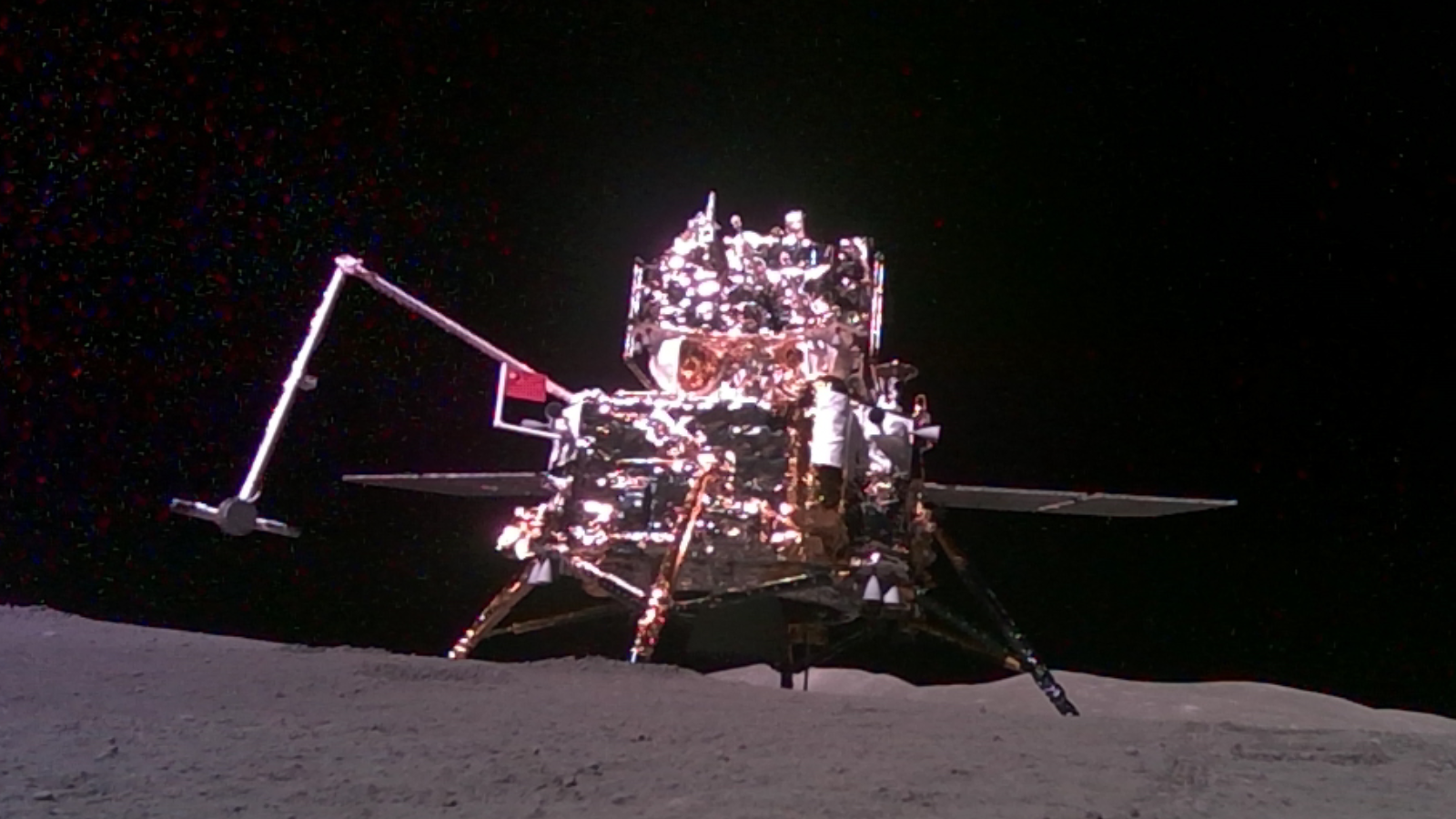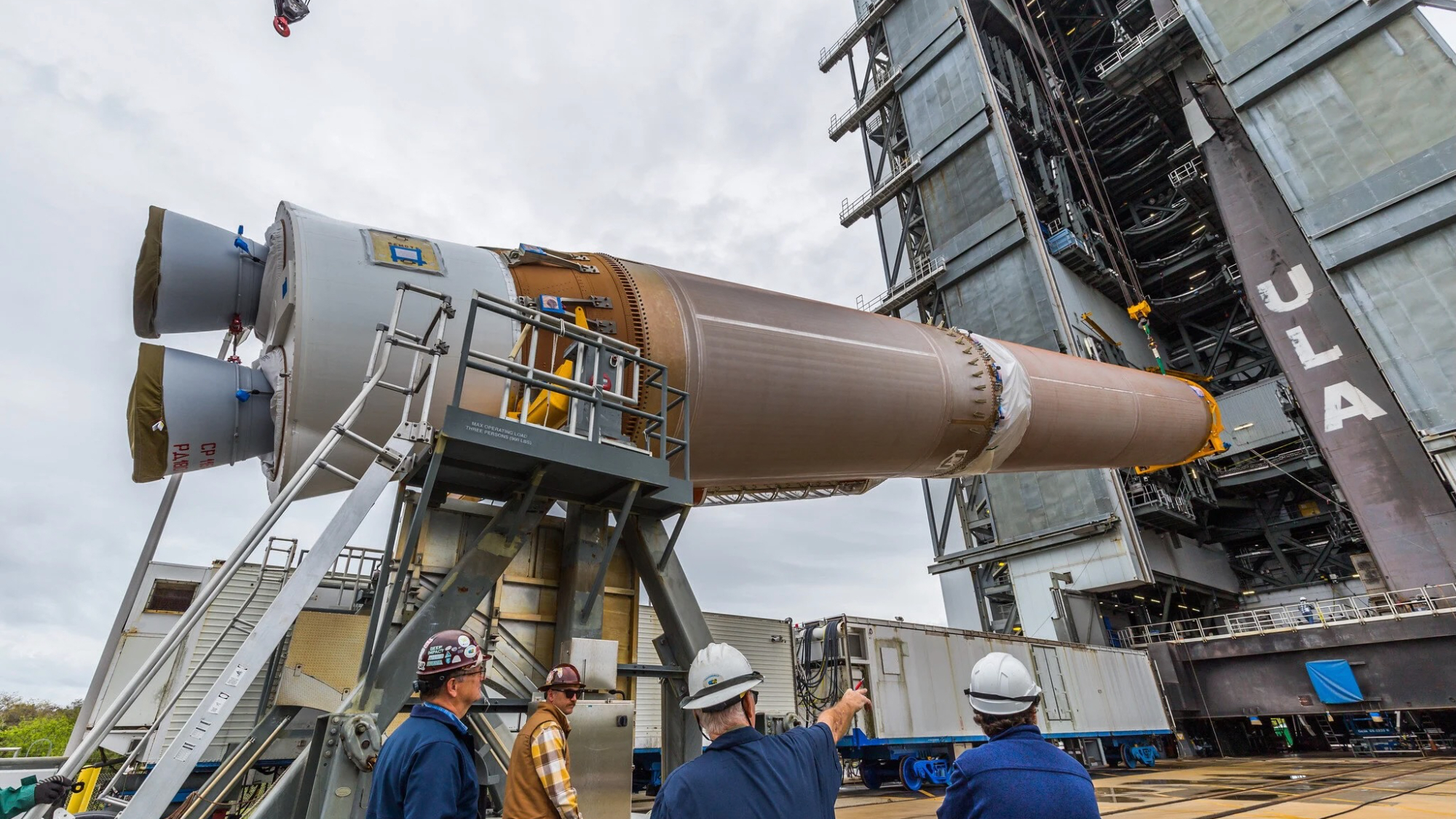Is the end near for Mars Odyssey? Trump's proposed 2021 budget could doom long-lived mission
The new budget request includes a massive cut to Mars Odyssey that effectively ends its mission.
![NASA's Mars Odyssey spacecraft passes above Mars' south pole in this artist's concept illustration. The spacecraft has been orbiting Mars since October 24, 2001. The spacecraft will serve as a vital relay for NASA's Mars rover Curiosity's landing on Aug. 5, 2012. [Related: <a href=http://www.space.com/16385-curiosity-rover-mars-science-laboratory.html>Mars Rover Curiosity Landing Coverage</a>]](https://cdn.mos.cms.futurecdn.net/6MxVQHVKZ6n7Q5tGsv2vjP.jpg)
NASA's longest-running Mars mission may be on the chopping block.
While President Donald Trump's 2021 budget request clearly threatened NASA missions like the jet-borne telescope SOFIA, another potential shutdown was tucked inside the request. Proposed cuts to the 2001 Mars Odyssey program would bring its budget to a scant million dollars a year, effectively terminating the mission. The budget request is just that, a request; Congress makes the ultimate decision about budgets and can choose to continue funding the mission. Nevertheless, the threat has Mars scientists anxious about the mission's future.
"I can't think of any situation where you would say, OK, let's just turn it off," said Tanya Harrison, a planetary scientist who studies Mars and has relied on Odyssey observations. "You never know what you're going to find if you keep going with these missions."
Related: Mars Odyssey: Pictures from longest Mars mission
More: A brief history of Mars missions
Odyssey launched in April 2001, arriving in orbit around the Red Planet six months later. Within a year of its launch, the spacecraft found water ice beneath the ground, the first direct evidence of subsurface water on the Red Planet. Since then, the spacecraft has made a number of important discoveries and observations, including the longest continuous observations of Martian weather.
But science isn't all Odyssey does. Right now, it's also the primary communications connection for the Curiosity rover. "It's the workhorse for sending data back from the rovers," Odyssey team member Phil Christensen told Space.com. Christensen, a planetary scientist at Arizona State University, leads the Thermal Emission Imaging System (THEMIS) instrument on Mars Odyssey. With NASA's next Mars rover, Perseverance (formerly known as Mars 2020), scheduled to arrive in February 2021, a communication crisis could become a future concern.
The proposed defunding is even more puzzling, the scientists said, because the spacecraft is in relatively good health and has enough fuel to last up to a decade longer. "Something else [on the spacecraft] will die before we run out of fuel," Christensen predicted.
Get the Space.com Newsletter
Breaking space news, the latest updates on rocket launches, skywatching events and more!
True, a series of strong solar flares put one instrument out of commission in 2003. And the spacecraft lost one of its reaction wheels in 2012, though its existing three are sufficient to point Odyssey in the right direction. But despite approaching its second decade, the spacecraft appears to have a bright scientific future in store — assuming it survives the 2021 budget proposal.
Budget woes
The concerns all stem from Trump's budget request, a document the executive branch sends Congress to start the annual budget process. The request outlined presidential priorities and how the administration would like money to be allocated for the fiscal year beginning in October.
That request highlighted the proposed cancellation of the SOFIA and WFIRST space telescopes, the latter of which previous requests have also targeted. In contrast, Odyssey's changes were tucked away in hundreds of pages of documents. There, a chart cuts Odyssey's budget from $11.5 million in 2019 to $1 million in 2021 and no funding in later years (fiscal year 2020 is only partially enacted at this point and so is not listed). No explanation for it is given.
It's easy to shrug off the long-lived mission, which has already received eight mission extensions. But when it comes to spacecraft, a functioning mission is worth more than might be expected. A colleague once told Christensen that a pile of parts is worth a certain amount value, which increases when the parts are assembled and again when a spacecraft survives the rugged testing required of space-faring machinery. But once the spacecraft is functioning at Mars, the value is without measure.
"When it's in orbit and has proven itself for 20 years, it's literally a priceless resource," Christensen said. "Why would you turn off something that's already there and working and doing a great job?"
Money is most likely the motivating factor. The NASA budget tends to be a zero-sum game, with few overall increases. And the agency wants to beef up a program to bring samples home from Mars, which generally requires moving money from another NASA column in the budget request. That's what Christensen suspects is happening.
Odyssey isn't the only Mars mission facing a requested budget reduction. The 2021 budget also proposes cutting the Curiosity rover's funds by about 25%, a substantial hit for the brave little rover. Christensen suspects that the $10 million cut from Odyssey and $10 million from Curiosity has all been applied to a sample return mission. At the same time, the Mars Future Mission program request jumped by nearly $200 million in 2021 alone, with funding forecast to increase further over the next five years.
But to Christensen, it doesn't make sense to scrap Odyssey to make that happen. "Sample return is going to be a multibillion-dollar endeavor," he said. "In the big picture, saving $10 million isn't really that important."
Bringing rocks back from Mars is something Mars scientists have long fought for. Coincidentally, Christensen said he's spent many years advocating for sample return because he thinks it's important. And he's sure that shutting down Odyssey isn't something that NASA administrators are undertaking lightly.
"They've got some tough decisions to make," he said.
A rock and a hard place
NASA has struggled through proposed budget cuts in the past that failed to kill their missions. The SOFIA "telescope on a plane" mission has lost funding in presidential budget requests several times over the past few years, yet it's still flying.
But if Congress goes along with the Odyssey cancellation, the process will be long and complicated. The Odyssey mission control room sits not at a NASA center but at Lockheed Martin's Colorado office.
A spacecraft can't just be turned off, especially not one orbiting a world with potentially habitable environments, like Mars. Exactly how Lockheed Martin would decommission Odyssey has not yet been disclosed. According to a member of the Odyssey team who wished to remain anonymous, NASA has declined to acknowledge the proposed budget cut to the team or take steps to decommission the spacecraft, according to team members.
NASA did not respond to requests from this reporter for the decommissioning plan and postponed interview requests, At NASA's request, Lockheed Martin canceled a scheduled interview to discuss the subject, leaving not only the Odyssey team but also the public in the dark.
In January, NASA and Lockheed Martin shut down the Spitzer Space Telescope, an infrared instrument orbiting the sun behind Earth. That decommissioning took roughly six months of coordination between the two organizations. "It's not a trivial process to decommission a spacecraft," Christensen said.
To close its mission by October 2020, when the proposed 2021 budget goes into effect, the spacecraft would likely have to begin its decommissioning program about six months earlier. If the budget hasn't been sorted out by May 1, 2020, the Lockheed Martin team may find itself between a rock and a hard place.
One option is to continue operating the spacecraft as normal, fingers crossed tightly for a budgetary rescue. If Congress stands by the spacecraft, the mission will continue into its second decade and hopefully beyond that. But otherwise, the private company may find itself scrambling at the last minute to rush the decommissioning process, potentially causing entirely new problems.
The other, more likely option according to the confidential source is that the company will balk at the potential funding loss and begin the shutdown process. (Without comment from NASA or Lockheed Martin, it's unknown what other steps would be required to decommission the spacecraft.)
Both Christensen and the anonymous source said that they've heard rumors that Odyssey would dump its fuel at some point between May and October. Christensen speculated that could be a step to prevent potential explosions in the future, which would litter the Martian atmosphere with thousands of pieces of debris.
Once the spacecraft has dumped its fuel, even an increased budget wouldn't save Odyssey. Without fuel, the spacecraft won't be able to point or transmit. If unchanged, its current orbit should keep it drifting around Mars for another 30 years, per the guidelines that prevent a spacecraft from impacting a planet within 50 years of leaving Earth.
A continued presence
Odyssey has been in orbit for a long time. A child born when the spacecraft launched would be in their first year of college today. So a proposed cancellation is "not surprising, since the mission is so old," Harrison said. "The oldest missions tend to be put on the chopping block."
Odyssey carries what is currently the only infrared imager orbiting Mars. Over the last 19 years, that instrument, THEMIS, has produced an incredibly detailed view of the planet and its physical nature. Measuring the surface temperature at day and night provides insight into the properties acting on Mars today, such as wind and glaciation, as well as the volcanic processes of the past.
The spacecraft has also been able to study Martian weather patterns over its lifetime. "If you showed up on Earth and watched the weather for one year, you'd say, this is what the climate is like on Earth," Christensen said. "If you keep track of the climate over a 20-year period, then you have a totally different view of how the atmosphere is behaving."
Those records can have long-term implications for one day sending humans to Mars, and continued observations can only improve them. In 2018, a global dust storm single-handedly shut down the Martian rover Opportunity by obscuring its solar panels for an extended period.
The same phenomenon could endanger human habitats on Mars. "If we're going to send humans there, the weather's going to be really important," Christensen said. "To this day, we cannot predict when the next big Martian global dust storm is going to occur."
Threats to Odyssey may also affect other missions at Mars, since the spacecraft serves as a major communications hub for surface missions. Rovers carry very small antennae, perfect for sending data short distances but an option for the long transmission from Mars to Earth. Instead, they ping satellites orbiting the planet. Christensen said there are currently four spacecraft capable of relaying those signals home: Odyssey, NASA's Mars Reconnaissance Orbiter (MRO), NASA's MAVEN spacecraft and the European Trace Gas Orbiter. Of those, Odyssey does most of the heavy lifting.
"Odyssey is really good at communication," Christensen said. "We've done it for a really long time."
MRO, the most likely communication replacement, has had its own share of trouble since its 2005 launch. "It seems to have gone into safe mode more frequently [recently]," Harrison said. She remembered a period where the spacecraft was out of commission for four months, making it a tenuous replacement for Odyssey.
MAVEN is currently focused on studying the upper atmosphere. Its orbit was recently shifted to allow it to shoulder some of the burden of communication, but doing so limited its scientific observations. The European spacecraft could also serve as a redundancy, as long as the agency is willing to give up collecting some of its own scientific data to allow Curiosity and the future Perseverance rover, formerly known as Mars 2020, to phone home.
The tradeoff between orbital and surface science is something all of the potential replacements would face. Shutting down the working Odyssey mission would not only eliminate the science produced by the spacecraft itself but also cut into the time other orbiters can spend doing science.
Both Harrison and Christensen said that communication redundancies mattered. "Having that backup contingency is really important, especially as we're about to launch another rover to Mars," Harrison said. "The more communication relays we have to Earth, the better."
Christensen remains optimistic about Odyssey's odds of survival and suggested some alternative models that could support the spacecraft even if Congress does cut its funding. "I think there are creative ways to keep this mission alive," he said. The mission could become student-run, he said, providing undergraduate and graduate students with the hands-on training they need and allowing them to engage with Mars. Or science could be outsourced to countries unable to send their own mission to the Red Planet, in exchange for additional funding. Or a college or university could step up to run the spacecraft and handle the funding.
"These things are too priceless to just flip the switch when you don't have to," Christensen said.
Harrison echoed that sentiment. "These missions are so complicated and we put so much effort into them that it seems like a waste to turn them off from a budget standpoint if they're still working," she said.
- Trump calls for $25 billion NASA budget for 2021 to boost moon and Mars goals
- Trump's 2021 NASA budget request supports X-59 experimental jet
- Space Force gets $15.4 billion in 2021 budget request
Follow Nola on Facebook and on Twitter at @NolaTRedd. Follow us on Twitter @Spacedotcom and on Facebook.
OFFER: Save at least 56% with our latest magazine deal!
All About Space magazine takes you on an awe-inspiring journey through our solar system and beyond, from the amazing technology and spacecraft that enables humanity to venture into orbit, to the complexities of space science.
Join our Space Forums to keep talking space on the latest missions, night sky and more! And if you have a news tip, correction or comment, let us know at: community@space.com.

Nola Taylor Tillman is a contributing writer for Space.com. She loves all things space and astronomy-related, and enjoys the opportunity to learn more. She has a Bachelor’s degree in English and Astrophysics from Agnes Scott college and served as an intern at Sky & Telescope magazine. In her free time, she homeschools her four children. Follow her on Twitter at @NolaTRedd
-
newtons_laws Bearing in mind it will have cost $hundreds of millions to build and launch Odyssey into successful Mars orbit it seems incredibly short sighted to close down an operational mission that is still gathering valuable science data and providing an important communication link for other Mars missions, all to save $10 million per year. The English phrase "penny wise and pound foolish" springs to mind...Reply -
fr rapp a terrible waste if they do decomission it Possible sell it to a private org, to operate it and sell the data at a 0 sum price or see if donations to keep it operational at least a 5$ donation or such from the public might be just what it needs perhaps lockheed martin could do a crowd funding to make up some of the cost "" just thinking out loud ""!!!!!!!!!Reply -
Lovethrust To quote Samuel L. Jackson... “everyone needs to just calm the @#$&* down”. This is not going to happen, Presidents and Congress have been playing these games forever. Congress is not going to defund it!Reply -
fr rapp we can hope but you never know about these politicians they get something in their heads (i wont say brains as im not sure they have one) and you have to beat them over the head to change their thinkingReply










